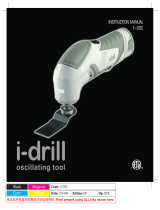
6
19. Be sure that there are no cracks or breakage on
the pad before use. Cracks or breakage may
cause a personal injury.
20. Do not use accessories which are not specifi-
cally designed and recommended by the tool
manufacturer. Just because the accessory can be
attached to your power tool, it does not assure safe
operation.
21. Wear personal protective equipment. Depend-
ing on application, use face shield, safety gog-
gles or safety glasses. As appropriate, wear
hearing protectors, gloves and workshop apron
capable of stopping small abrasive or workpiece
fragments. The eye protection must be capable of
stopping flying debris generated by various opera-
tions. The dust mask or respirator must be capable
of filtrating particles generated by your operation.
Prolonged exposure to high intensity noise may
cause hearing loss.
22. Keep bystanders a safe distance away from work
area. Anyone entering the work area must wear
personal protective equipment. Fragments of
workpiece or of a broken accessory may fly away
and cause injury beyond immediate area of opera-
tion.
23. Never lay the power tool down until the acces-
sory has come to a complete stop. The spinning
accessory may grab the surface and pull the power
tool out of your control.
24. Do not run the power tool while carrying it at
your side. Accidental contact with the accessory
could snag your clothing, pulling the accessory into
your body.
25. Do not operate the power tool near flammable
materials. Sparks could ignite these materials.
26. Do not use accessories that require liquid cool-
ants. Using water or other liquid coolants may result
in electrocution or shock.
27. Always be sure that the tool is switched off and
unplugged before carrying out any work on the
tool.
28. If working place is extremely hot and humid, or
badly polluted by conductive dust, use a short-
circuit breaker (30 mA) to assure operator safety.
29. Always be sure you have a firm footing. Be sure
no one is below when using the tool in high loca-
tions.
SAVE THESE INSTRUCTIONS.
WARNING:
DO NOT let comfort or familiarity with product
(gained from repeated use) replace strict adherence
to safety rules for the subject product. MISUSE or
failure to follow the safety rules stated in this instruc-
tion manual may cause serious personal injury.
FUNCTIONAL DESCRIPTION
WARNING:
• Always be sure that the tool is switched off and
unplugged before adjusting or checking function
on the tool. Failure to switch off and unplug the tool
may result in serious personal injury from accidental
start-up.
Switch action (Fig. 1)
CAUTION:
• Before plugging in the tool, always check to see that
the tool is switched off.
To start the tool, slide the slide switch toward the “I (ON)”
position.
To stop the tool, slide the slide switch toward the “O
(OFF)” position.
Adjusting the orbital stroke rate (Fig. 2)
The orbital stroke rate is adjustable. To change the orbital
stroke rate, turn the dial between 1 and 5. The higher the
number is, the higher the orbital stroke rate is. Preset the
dial to the number suitable for your workpiece.
NOTE:
• The dial cannot be turned directly from 1 to 5 or from 5
to 1. Forcing the dial may damage the tool. When
changing the dial direction, always turn the dial moving
it through each intermediate number.
Constant speed control
Electronic speed control for obtaining constant speed.
Possible to get fine finish, because the orbital stroke rate
is kept constant even under load condition.
ASSEMBLY
CAUTION:
• Always be sure that the tool is switched off and
unplugged before carrying out any work on the tool.
Installing or removing application tool (optional
accessory) (Fig. 3, 4 & 5)
WARNING:
• Do not install application tool upside down. Installing
application tool upside down may damage the tool and
cause serious personal injury.
• Install attachment tool in the correct direction according
to your work. Application tool can be installed at an
angle of every 30 degree.
Put an application tool (optional accessory) on the tool
flange so that the protrusions of the tool flange fit in the
holes in the application tool and secure the application
tool by tightening the bolt firmly with the hex wrench.
When using sanding application tool, mount the applica-
tion tool on the sanding pad so that it matches the sand-
ing pad direction.
The sanding pad has a hook and loop type fitting system
which allows easy and rapid fitting of a sanding paper.
As sanding papers have holes for dust extraction, mount
a sanding paper so that the holes in a sanding paper
match those in the sanding pad.
To remove a sanding paper, raise its end and peel it off.
Loosen and remove the application tool installation bolt
using a hex wrench and then take off the application tool.
When using application tools with a different type of
installation section, use a correct adapter (optional
accessory).






